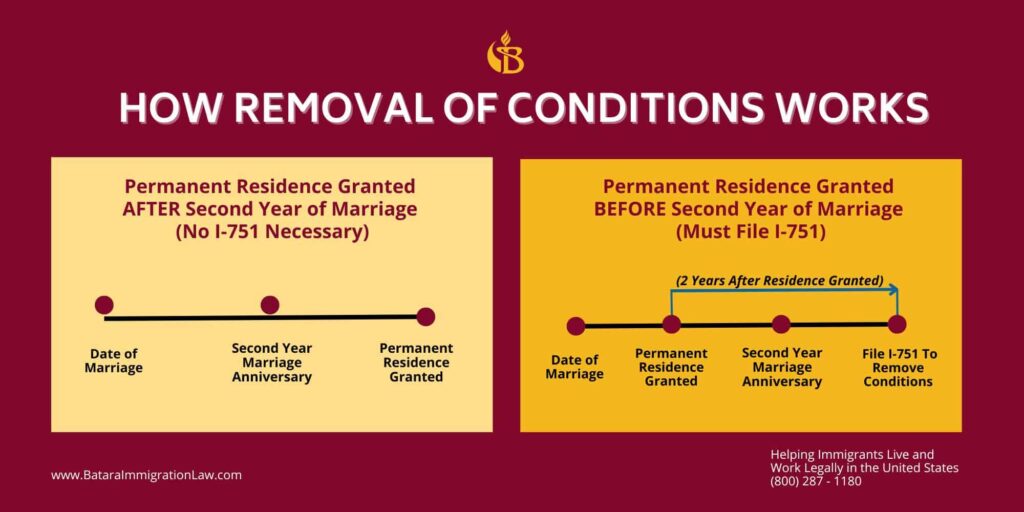
Table Of Contents
- What is conditional permanent residence?
- What happens at the end of the two-year conditional green card period?
- How long does the I-751 process take?
- What type of evidence is needed to win a 10-year green card?
- What happens if your spouse dies before you file the I-751 petition?
- Can you remove conditions if you separate or divorce before the two-year period?
- What happens if the filing deadline for the I-751 petition is missed?
- When does time in conditional residency status count towards naturalization?
- If you get remarried after losing your I-751 case, can you file for a new green card?
- What happens after your I-751 petition is denied by USCIS?
What Is Conditional Permanent Residence?
If your spouse filed papers to immigrate you, but you were married for less than two years at the time of your approval for residency, your family-based green card status is only good for two years. This is known as conditional permanent residence.
Compare this to an immigrant spouse whose permanent residency status was granted after the couple’s second anniversary. Such couples are not required to file an I-751 petition. Instead, on the date that the immigrant wins a green card, the green card status is good for 10 years.

During the two years of conditional residency, green card holders have the same rights of a regular permanent resident. You can work, go to school, and even travel outside the country.
At the end of the two years, however, you have to again prove that your marriage is authentic and seek to remove the conditions on your permanent resident status and obtain full green card benefits.
What Happens At The End Of The Two-Year Conditional Green Card Period?
Before the second year of your legal residency ends, you must file a Petition To Remove Conditions, Form I-751, along with updated documents showing that your marriage was a good faith and legitimate marriage.
The I-751 petition is required to be filed jointly with your spouse.
The government will not send you a notice to remind you that your two-year residency period is nearing its expiration date. It is your responsibility to know this deadline and to submit your paperwork to remove conditions on a timely basis.
The earliest you can file the I-751 petition is 90 days prior to the second anniversary of the date you were granted permanent resident status. If you file too early, your application will be returned.
At this point, if you are successful, the two year restriction will be lifted and you be granted 10-year permanent residence.
BATARA IMMIGRATION LAW INSIGHTS
10 Types Of Hard Cases We Help Immigrants Win (Wherever You Live)
How Long Does The I-751 Process Take?
In prior years, if there were no glitches, I-751 applications were generally reviewed and green card conditions were removed within a six-month process.
Yet, due to the increased backlog of cases pending with the USCIS, it is no longer out of the ordinary for these cases to now take between 18 – 24 months. Soon after you file your application, you will be sent a Notice by the U.S. Citizenship and Immigration Services (USCIS) extending your conditional resident status for a period of one year, while a decision on your application is pending.
During the one-year extension, you are still legally authorized to work and travel abroad.
In some cases, you may receive a second extension from USCIS if a decision has still not been reached within the 12 month period of the first extension.
What Type Of Evidence Is Needed To Win A 10-Year Green Card?
Essentially, the government imposes the conditional permanent residence requirement to ensure that short-term marriages are not based on fraud. As a result, USCIS will closely review that your marriage was legal at the outset, that you and your spouse are engaged in a legitimate (“bona fide”) marriage, and that your marriage has not terminated.
This means that the type of evidence you must submit is similar to the documentation you provided at the time of your green card marriage interview. However, the new information in the I-751 should pick up where your last set of materials left off.
You should file updated tax returns, bank statements, utility, telephone, rental or mortgage receipts, credit card invoices, photographs of special events with family and friends, as well as employment stubs showing medical, insurance, and retirement contributions for the past two years. If you have children, you should include information proof of school and medical enrollment, to the extent applicable.
However, sometimes a couple has a minimum amount of such formal evidence. This can lead to questions from the government pertaining to the couple’s relationship, as in the situation involving Arvand and Darlene, former clients of ours.
Arvand, an immigrant from India, entered the U.S. on a temporary visa as a computer engineer for one of the large social media companies. One afternoon, at a social outing with friends, he met Darlene. They were instantly attracted to each other and exchanged phone numbers.
A few years later they married. Soon after, Darlene, a U.S. citizen, petitioned Arvand for permanent resident status. He was granted a green card with conditions.
As required, they filed an I-751 to remove the conditions a little less than two years subsequent. Because they had few joint assents and separate bank accounts, the government questioned the legitimacy of their marriage.
They understood that if they lost the I-751, this would terminate Arvand’s green card status.
Unsure how to handle this situation, they decided to seek legal advice. After talking to a few colleagues, Arvand contacted our office based on our history of helping other Indian immigrants with various legal concerns.
After assessing the reasons for Darlene and Arvand’s financial actions, we developed a plan for responding to the government’s concerns. The goal was not only to explain the rationale behind their choice not to commingle assets and finances, but also to maximize their non-economic evidence supporting the bona fide nature or their relationship.
Four months later, their I-751 petition was approved.
What Happens If Your Spouse Dies Before You File The I-751 Petition?
If your husband or wife dies during the two-year conditional residence period, you will not be required to file a joint petition. But for purposes of the I-751 petition, you will still need to illustrate that your marriage was a bona fide marriage and was not entered into solely to obtain an immigration benefit.
Can You Remove Conditions If You Separate Or Divorce Before The Two-Year Period?
The I-751 is a joint petition. If your spouse is willing to submit the petition along with you, even though you are separated and living apart, it is likely immigration authorities will seek additional evidence showing that your marriage was legitimate and in good faith. These are the marriages that are closely reviewed for possible immigration fraud.
If your spouse is not willing to sign the I-751, you will need to request a waiver that allows you to file to remove the conditions alone, without your spouse.
If you are not divorced, your waiver will need to based on a showing that you suffered domestic violence and spousal abuse or you will suffer extreme hardship if the permanent residence conditions are not removed.
On the other hand, if you are divorced by the date of the filing of your petition, you will be allowed to file the I-751 by yourself.
In all of these situations, the validity of your marriage will be stringently tested. The burden of proof and supporting evidence needed to demonstrate you merit a waiver from the joint filing requirement is quite high in these cases.
For a more complete discussion on how to handle a situation involving either a divorce or separation, click here: Can A Separated Immigrant Spouse Remove The Conditions On Her Green Card Without A Joint Petition?
What Happens If The Filing Deadline For The I-751 Petition Is Missed?
A failure to file your I-751 petition on a timely basis will result in a termination of your conditional resident status.
Upon proving “good cause and extenuating circumstances” for the delay, USCIS may waive your untimely filing and allow you to proceed. This is a risk you should try to avoid.
Some examples that might constitute good cause and extenuating circumstances include hospitalization, emergency, the death of a family member, work-related commitments, or military obligations. The key is to show circumstances that were beyond your control.
When Does Time In Conditional Residency Status Count Towards Naturalization?
Immigrant spouses who become permanent residents via marriages to U.S. citizens are eligible to apply for naturalization on the third anniversary of being granted green card status.
The two-year period of conditional residency is applied towards the three year requirement for citizenship, even if their I-751 removal of conditions petition is pending.
If You Get Remarried After Losing Your I-751 Case, Can You File For A New Green Card?
If you lose your conditional residency case, and later re-marry, you are entitled to seek permanent residency through a new spouse.
Of course, why your previous marriage ended will be questioned by USCIS officers. If there were allegations of green card fraud, this could lead to a denial of the new I-130 petition filed by your spouse.
In addition, if you entered the United States under a fiancé visa, you will not be allowed to seek permanent residence through a new marriage.
What Happens After Your I-751 Petition Is Denied By USCIS?
If you lose your case to remove the conditions on your permanent residency, you will be deemed out of status and start to accrue unlawful presence as soon as your conditional green card expires.
Perhaps the USCIS officer made a mistake, applying the law incorrectly or overlooking important evidence. In such cases, don’t let your denial go forward without challenge. In such cases, you should file a motion to reopen and reconsider.
Even when your case is denied for insufficient evidence, years later, the government may dispute your remarriage on the basis that it was based on a less-than good faith marriage. By filing a motion to contest the USCIS denial, you develop a record for officers who study your file in the future.
If you file a motion to reopen or reconsider but lose – or if you do not file any motions – you could be referred to immigration court. You may be served with a Notice To Appear placing you in deportation proceedings.
When your court hearings begin, you are allowed to renew your I-751 application if you believe USCIS made an error.
You could also request any defenses applicable to your situation, including relief claims based on domestic violence at the hands of your spouse, adjustment of status via a new marriage, or cancellation of removal due to the hardship your U.S. or permanent resident children or parents will suffer if you are removed from the United States.
But if you assess the above nine issues honestly in advance, you’ll be in far better shape to remove the conditions on your green card, earn full permanent resident status, and avoid immigration court altogether.
Ready to take a serious and honest look at the strengths and weaknesses of your immigration case? Let’s get started with a personalized strategy and planning session . . .




